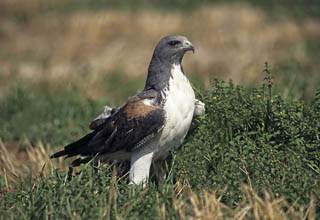
Yellow-crowned Night-Heron at Stratton residence in Porter County.
Yellow-crowned Night-Heron (Nyctanassa violacea) by Kristin Stratton
On June 4, 2014 while making a pot of coffee to start the day, I was looking out of my kitchen window. I noticed a small heron like bird perched on my neighbor’s pool deck, which is about an acre away from where my kitchen window was. I was a birder at the time making a transition from backyard birding to real birding. I thought to myself “what is that a baby great blue heron?” I didn’t know so I grabbed my binoculars, cell phone and camera and ran outside in hopes to get a better look and some photos. Luckily the bird was still perched on the deck and I could get a better look. I saw that it had a black and white head, so I googled, small heron with black and white head. Yellow-crowned Night Heron came up in the search and I knew immediately this was my backyard bird! I was excited, I had never seen one and at the time, l must admit, I didn’t even know they existed in Indiana!
As I stood there staring and snapping of photos the bird walked around on their deck the eventually few to the woods and landed on a limb in the tree line. I knew I had something special, so I went back inside and quickly flipped though my “Birds of The Indiana Dunes” book. When I got to the Yellow-crowned Night Heron page (45) I read that it had a finding code of 8. A finding code 8 means 1 bird every 2 years. It meant that this is a rare occurrence in Indiana! Now I was even more excited and went to look at the bird some more, but it was gone. I was crushed that I had not spent more time looking at it. I knew Brad Bumgardner, naturalist at The Indiana dunes State Park at the time, was a birder as I had been on some bird walks in the park with him. I knew he would want to hear about this. So, I got on Facebook and posted one of my photos on the IDSP Facebook page. Brad responded with “those are pretty rare!” I responded with “that is why I posted it here.” From there Brad messaged me about birders visiting our house because local birders would want to see such a rarity. I agreed, and the messages started pouring in. I was sad to say that I had not seen the bird all day and that I would be up early to check for it.
The next morning my husband was leaving for work at 4 A.M. He woke me and said, “your bird is back, it is in the front yard!” I jumped out of bed to go see but it was gone by then. I reported that it was seen again that morning. Over the next few days the bird was seen often stalking and pulling earth worms the size of small snakes out of my backyard! It was quite amusing to watch. The bird stayed in our yard feasting on worms till June 9th! Many birders stopped by to have a look for the bird but from what I remember only a handful got the special chance to see it.
Yellow-crowned Night-Herons are small herons with stocky bodies and short, thick necks, and short legs. They have large, blocky heads with thick, relatively short bills. In fight, the wings are broad and rounded. Adults are cloudy gray birds with a bold face pattern: a black head with large white cheek patch, and a creamy yellow crown and head plumes. Immatures are brown with fine white spots on the back and wings; the underparts are streaky. The legs are orange-yellow, brighter in adults. Yellow-crowned Night-Herons slowly stalk prey in or near shallow water, usually alone, with a hunched, forward-leaning posture. They perch quietly on stumps and tree branches, often over water. Most of their prey is crustaceans, especially crabs and crayfish.
They are most common in coastal wetlands barrier islands, saltmarshes, drainage ditches, and mangroves; they also occur inland along bottom land forests, swamps, and sometimes wet lawns or fields. If it weren’t for me being a birder, that bird would have gone unnoticed. From then on, my birding hobby had changed. I wanted to see more, I wanted to see rare birds, I wanted to see as many birds in Indiana as I could. With the help of many Indiana birders, eventually I did. Last year (2017) I did a big year and reached my goal of seeing 300 birds in Indiana in a year. By the end of the year, 301 was my final number joining an elite group of only fourteen others to do the same in Indiana.











